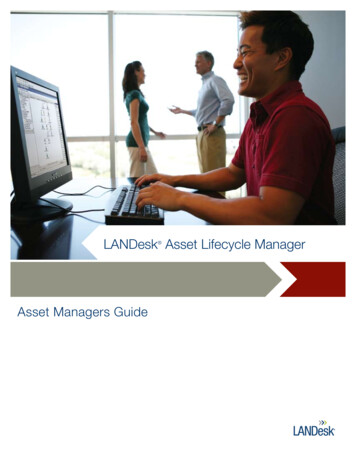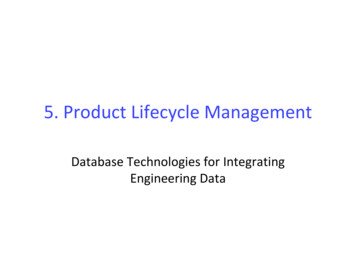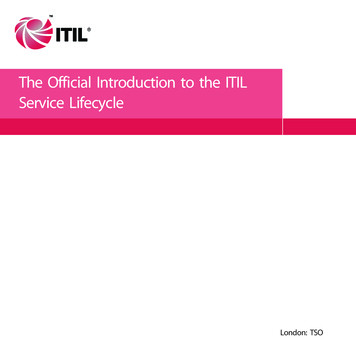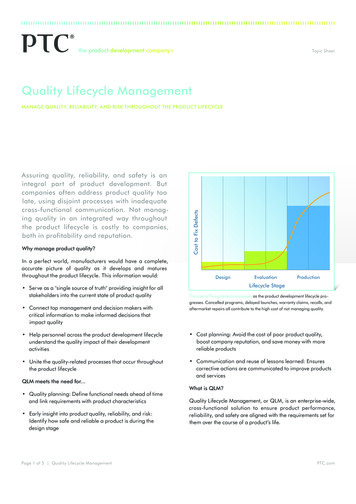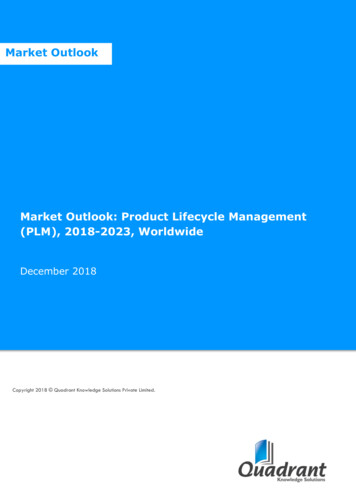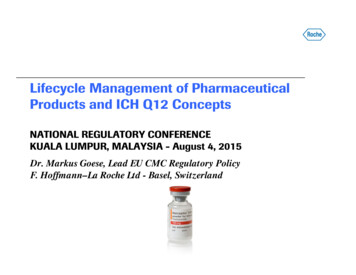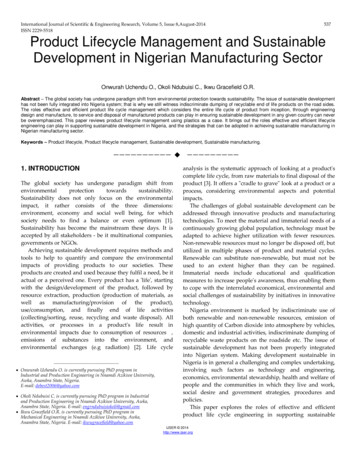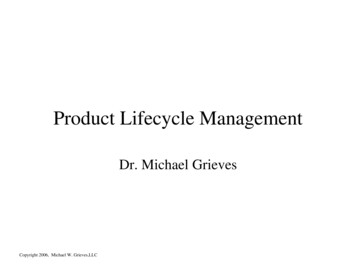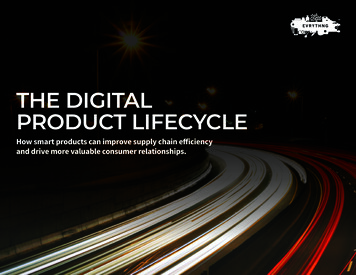
Transcription
THE DIGITALPRODUCT LIFECYCLEHow smart products can improve supply chain efficiencyand drive more valuable consumer relationships.
IntroductionThe rise in connectivity and the Internet of Things (IoT) is transforming everything, from the waywe communicate with one another to the way we interact with the world around us. This year, thenumber of connected devices surpassed the global population, and it’s estimated that by 2020,there will be 20 billion connected devices1—each generating its own unique dataset.This presents an exciting opportunity for consumer product manufacturersto digitize their physical products and make them “intelligent.” Everydayitems such as a bottle of wine, a T-shirt or a box of cereal can be enhancedwith web connectivity and a digital identity, making them smart, trackableand interactive. These digitized products can generate cost efficiencies andnew revenue streams throughout the product lifecycle.The rise of smart products has created a new concept: The DigitalProduct Lifecycle.Digitized products create new data streams at every point along thesupply chain—data streams that can be used to improve every aspectof the product journey, from manufacturing to post-purchase customerexperiences. Innovative manufacturers and retailers are harnessing thesenew data streams to facilitate traceability, verify product authenticity,optimize inventory and even combat the gray market.In the pages that follow in this Digital Product Lifecycle eBook, we’llshow you:They also drive new types of consumer engagement. Using mobiledevices to scan physical products, consumers can learn more about them,or interact with them in different ways both in-store and out-of-store.Thus, products become a new channel for marketing, e-commerce andbrand communications, presenting companies with new ways to engageconsumers—before, during and long after a purchase.1 t-time/The Digital Product Lifecycle weaves together the disparate stages of thesupply chain management and customer relationship management in aconnected, cyclical way, powered by real-time data. How data can help improve supply chain agility and visibility How you can use products to build deeper relationships with yourcustomers How you can leverage connected technology to increase purchasesand gain insights into consumers beyond the point of saleWe invite you to read on, get connected and let us know what you thinkat hello@evrythng.com.1
Digital ProductLifecycle StagesTraditionally, many enterprises have drawn a line between supply chainmanagement and consumer relationship management pre- and post-sale.There’s everything that happens before a product is sold, and then there’severything that occurs afterward. Different systems, teams and functionsare typically responsible for the pre-sales process (i.e., Development,Manufacture and Distribution) than are responsible for point of sale andbeyond. And siloed systems have made it difficult to connect the dots.This is no longer the case. The digitization of physical products allowsthe seamless flow of data across the entire supply chain and customerrelationship management process. Not only is this now technicallypossible, it’s quickly becoming a competitive imperative.EVRYTHNG was founded to enable any product to be “#BornDigital .” OurIoT SaaS Platform gives a unique digital identity to every item, embeddedinto the product or its packaging at point of manufacture. This identifyis stored in the cloud, and can be accessed remotely at any time. As aresult, products can generate and respond to real-time data throughouttheir lifecycle, driving greater operational efficiency, better consumerengagement and higher brand advocacy.2
Digital Product Lifecycle StagesHow new data streams from #BornDigital products enableinsights and applications throughout the product’s lifecycle.TMParts/Materials SourcedMaterials & Ingredients, Provenance,Sustainability Data.ManufactureWhen, Where Made, Packaging Components,Batch, Production Line, Factory.RecycleReplenishment Data, Where Recycled,Sustainability Data, Change of Ownership.Post-Purchase/ConsumptionLive Usage and Consumption Data, ProactiveMonitoring, Behavioral Patterns (e.g., Who, When,Where, How Often, Promotion Response).DistributionLogistics Details, Stock Location &Quantity, 3PL Performance.Retail/WholesaleStore Locations, Inventory Levels,Product Authenticity.PurchaseProduct Performance, Shopper Engagement,Purchase Volumes, Changes in Demand.3
Digital Product Lifecycle StagesParts/Materials SourcedDigitized products enable brands to aggregate and manage criticalinformation about the manufacturing process (e.g., raw materials andcomponents used, dry goods such as packaging or glassware, whetherproducts were sustainably sourced or farmed). This level of transparencyis essential for brands to locate affected items in the event of a qualitycontrol issue, or to provide consumers with detailed and up-to-the-minuteinformation about the product they’re purchasing.ManufactureDigital product lifecycle management means gathering data from disparateERP and manufacturing systems, as well as from the products themselves.This data can be combined to create a digital record of every individualitem—when and where it was produced, including the batch, production lineand factory in which it was manufactured. End-to-end traceability relies oncentralizing this data, making it uniform, searchable and accessible in realtime via the web.4
Digital Product Lifecycle StagesDistributionReal-time visibility throughout the extended supply chain, across multiple3PL partners, helps reduce diversion, improve inventory managementand increase logistics efficiency. Smart products enable supply chainmanagers to view product journeys in real-time, and can help themoptimize shipments and suppliers, as well as gain insight into volume andchanges in demand in particular locations.Retail/WholesaleFor many manufacturers, retail is a closed-loop environment, offeringlittle or no visibility into inventory levels, demand changes or productperformance. How can you ensure stock is in the right place at theright place time if your data is a week old, and summarized in a staticspreadsheet? Smart products communicate in real-time with thecloud, enabling Just-in-Time replenishment in-store and omnichannelexcellence.5
Digital Product Lifecycle StagesPurchaseThe point of purchase is where Born Digital products first meet consumers. Fromapparel to electronics, these smart products can serve as their own marketingchannels, educating potential customers about the materials used to create them,style tips, nutritional information, rewards programs and more.Brands can update information about their products remotely, removing costlyin-store updates. They can also begin an ongoing relationship with customersthrough data captured in-store, and gain added insight into the retail experience.Post-Purchase/ConsumptionBrand managers can treat their smart products as a communications channeland send offers or cross-promotions to devoted users, or alerts to those whohaven’t used or worn their product in a while. In fact, smart products drivehigher engagement rates than any other owned-media source.2 Productinteraction drives consumer data acquisition and creates an ongoing 1:1conversation with customers that builds brand loyalty.Perhaps more important, Born Digital products generate data constantly,helping brands understand real (and not merely self-reported) consumerbehavior and usage trends, as well as consumer insights that can be leveragedfor future marketing and product development initiatives.6
Digital Product Lifecycle StagesRecycleConsumers can responsibly dispose of smart products by scanning theiritem and finding out where nearby recycling locations are. In so doing,brands can meet sustainability targets and at the same time get visibility ofwhen consumers may need to purchase replacements, presenting an upsellmarketing opportunity.7
Digital ProductLifecycle In ActionHow brands are using smartproducts to cut costs and createnew value.8
Digital Product Lifecycle In ActionGray MarketI was bottled in Cognac in2018, and packed in a casedestined for Singapore. Thisscan shows I’ve ended up inthe wrong market.Digitized items, cases and pallets enablebrands to track location and quantity oftheir assets all around the world. Real-timedashboards and mobile apps show whetherinventory arrived on time and in full. Brandscan set software rules in the cloud to detectif stock is in the right location and country,and take action when issues arise. 3PLpartner performance can be measured inreal-time using specific KPIs.SMARTPRODUCTSDASHBOARD9
Digital Product Lifecycle In ActionAT POINT OF SALEProduct AuthenticityBrands can fight counterfeiting usingcrowdsourced data from smart products.Each serialized item has its own uniqueidentity in the cloud, connected to a smartlabel or code on the item. Genuine productscan confirm their authenticity in realtime when scanned by brand inspectors.More important, as consumers interactwith products for brand experiences, theirscans serve as a large-scale field team ofinspectors, revealing when fake or copieditems are detected, with real-time alertswith geolocation details.I’m real.I’m fake.Counterfeitscan detected.SMARTPRODUCTSDASHBOARD10
Digital Product Lifecycle In ActionStock ManagementWith digitized products, your supply chaincan become more responsive to in-storedemand so you can avoid costly stockoutsand over-stocking. Collecting real-time POSdata in the cloud on every individual itemgives granular dynamic product quantitiesin store and can automatically triggerreplenishments from local distributioncenters. It also provides detailed insightson who is buying your products to helpoptimize production and logistics planning.Only 1 left in store.More stock required.IN STORE11
Digital Product Lifecycle In ActionQuality Control& RecallsWith digitized products, it’s over 40X fasterfor companies to trace where any productis in the world, and the components thatwent into them. Every smart productstores data about itself in the cloud, whichis accessible from anywhere. This alsomeans consumers can simply scan smartlabels with their smartphone to see productprovenance data or find out if the product ispart of any brand recall.SMARTPRODUCTSDASHBOARDWarning – initiateproduct recall forall items made onproduction line C inbatch 400.This cereal packetis part of a faultybatch that hasbeen recalled.IN STORE12
Digital Product Lifecycle In ActionProduct Informationand ProvenanceI’m organic and contain aunique blend of essentialnatural oils and plantextracts. Scan me for beautytips once you get home, andopt-in to receive couponsand new offers!Brands can use smart products to drive-instore purchases and promote consumer trustby letting shoppers scan to access couponsor get additional product information, suchas sustainability information, nutritionaldata, style tips or care instructions. Productinformation can be updated remotely inreal-time, so companies can easily push newpromotions and offers or meet stringentnew transparency labeling regulations withease. Information can be contextualized bycountry or region for greater targeting.13
Digital Product Lifecycle In ActionExperiences & LoyaltyProgramsConsumers can scan product postpurchase to gain personalized rewards andpromotions, activate and manage loyaltyprograms, reorder items or access relevantproduct content (e.g., workout videos orplaylists to accompany a pair of shorts,VIP experiences, contests). This creates anongoing relationship with the brand, andgives brands owners visibility beyond POSinto not just who is buying their product,but how they are using them. Companiescan send news of new features, services,and products directly to customers, withoutupdating external packaging or beingdisintermediated by third-party retailers.Nice job! You’verun 10 milesthis week!Here’s a newplaylist to keepyou going!Since all data is cloud-based, this valuableconsumer data can be connected withexisting CRM platforms and marketingautomation tools, building more robustconsumer profiles to be used in retargetinginitiatives.14
Creating the DigitalProduct LifecycleBrands who want to realize the benefits of smart products canfollow these four steps to get started:1.Put digital triggers on your products. The first step in unlocking newdata streams is to put digital identifiers onto your products, cases orpallets. These can take the form of embedded sensors, RFID or NFCchips, printed electronics or QR codes and barcodes; which allow themto interact with readers, smartphones and sensor networks.2.Create digital identities in the cloud for your physical products.The key to total visibility throughout the supply chain and deliveringpersonalized product experiences is having a unique, secure ID andprofile for each serialized item. This ID is stored in the cloud, and canbe used to is used to collect data from physical products and to triggerapplications or notifications.3.Connect smart products to other enterprise and partner systems.Smart products remove the siloes that exist in many traditionalorganizations by aggregating data from ERP, CRM and MarketingAutomation platforms and sharing with other platforms in the widerdigital ecosystem. Get your systems connected to take advantage of theentire digital product lifecycle.4.Build applications and gather analytics. Deploy web and mobileapplications built around your smart products to improve supplychain efficiency, boost customer engagement and grow brand loyalty.Leverage the data generated using external BI systems or customanalytics dashboards to provide insights, trends and business value.15
About EVRYTHNGEVRYTHNG is the market leading Internet of Things SaaS Platform connecting consumer products to the Weband managing real-time data to drive applications and analytics throughout the product lifecycle. The world’sleading consumer product manufacturers work with EVRYTHNG to manage billions of intelligent identities inthe cloud for their products.To schedule a demo and see how EVRYTHNG can help your business leverage the Digital Product Lifecycleapproach to grow your business, visit us at evrythng.com or drop us a line at hello@evrythng.com.
Product Lifecycle. The Digital Product Lifecycle weaves together the disparate stages of the supply chain management and customer relationship management in a connected, cyclical way, powe

